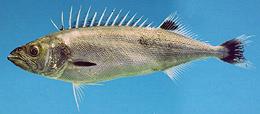 [family Carangidae]
[family Carangidae]
This is a modest size family, with about 25 species, only a few of which are commonly eaten. The Snoek is considered favorably, especially in South Africa, but a couple others are quite notorious. Photo by Brian Gratwicke, distributed under license Creative Commons Attribution-ShareAlike v2.0 Generic.
More on Varieties of Fish
(very large page).
 [Zeesnoek (old Afrikaans); Barracouta (Australia);
Thyrsites atun]
[Zeesnoek (old Afrikaans); Barracouta (Australia);
Thyrsites atun]
This fish is found in the subtropical regions of the southern seas around
the world, but only the continental shelf. it can grow to as much as 78 inches
and 13 pounds, but is typically 30 inches.
When early Dutch settlers came to South Africa, they depended a lot on
fish, as they had little access to meat animals. This fish reminded them
of the fresh water Snoek (Snook) they knew in Holland, but this was a
salt water fish, so they called it Zeesnoek. In South Africa, it is
only found on the west coast. IUCN listed NE (Not Evaluated).
Details and Cooking.
 [Lepidocybium flavobrunneum]
[Lepidocybium flavobrunneum]
This fish is found on tropical and subtropical continental shelves
worldwide. It can grow to 78 inches and 99 pounds, but is commonly
around 59 inches. This often mislabeled fish is outstandingly
delicious, but is also a "problem fish" - for details see
Details and Cooking.
Photo by US Government NOAA = Public Domain.
 [Ruvettus pretiosus]
[Ruvettus pretiosus]
This fish is found near the shores throughout the tropical and
subtropical regions of all the world's seas. It can grow to almost
118 inches and 140 pounds, but is commonly around 60 inches. It is
not fished deliberately, but shows up in by-catch. This fish has a
pleasant rich oily taste, which has tempted stores and restaurants
to mislabel it, which causes the same distressing problems as the
very similar Escolar, so for details see
Escolar - Details and Cooking.
Photo by US Government NOAA = Public Domain.
 [Hauliuli (Hawaii); Gempylus serpens]
[Hauliuli (Hawaii); Gempylus serpens]
This fish is common throughout the tropical and subtropical regions
of all the world's seas. It can grow to 118 inches, but is commonly
around 59 inches. The record weight is 140 pounds. It is not fished deliberately, but shows up in
by-catch. It is sold fresh, dried, as sausages and fish balls and
cakes. It can be cooked by any method, but is not eaten raw.
Photo by US Government NOAA = Public Domain.